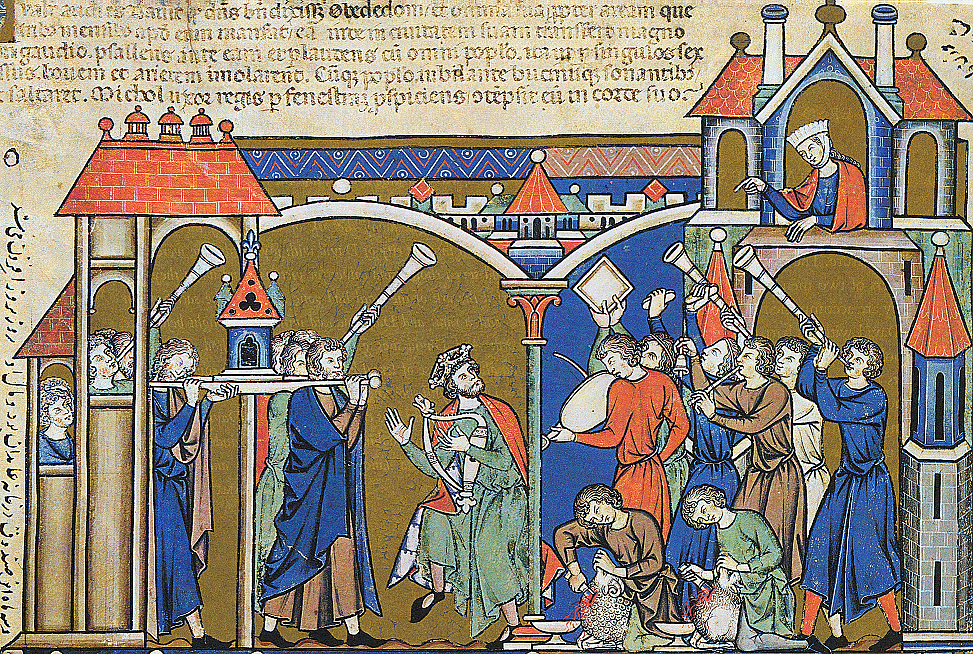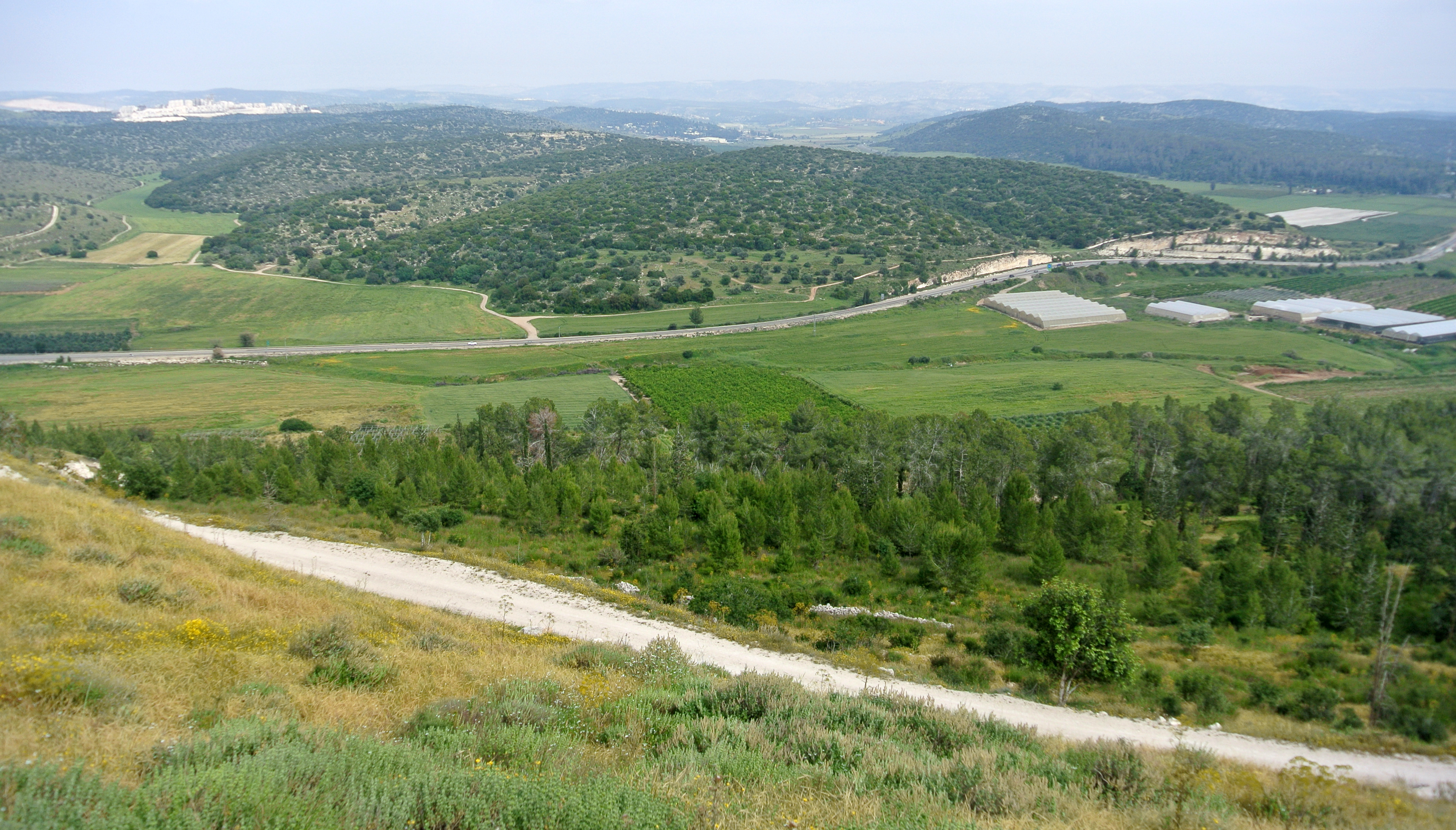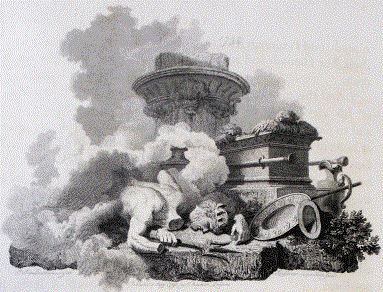|
1 Chronicles 10
1 Chronicles 10 is the tenth chapter of the Books of Chronicles in the Hebrew Bible or the First Book of Chronicles in the Old Testament of the Christian Bible. The book is compiled from older sources by an unknown person or group, designated by modern scholars as "the Chronicler", and had the final shape established in late fifth or fourth century BCE. This chapter describes Saul's downfall and the reasons of his rejection by God. The whole chapter belongs to the section focusing on the kingship of David (1 Chronicles 9:35 to 29:30). Text This chapter was originally written in the Hebrew language. It is divided into 14 verses. Textual witnesses Some early manuscripts containing the text of this chapter in Hebrew are of the Masoretic Text tradition, which includes the Aleppo Codex (10th century), and Codex Leningradensis (1008). There is also a translation into Koine Greek known as the Septuagint, made in the last few centuries BCE. Extant ancient manuscripts of the Septuag ... [...More Info...] [...Related Items...] OR: [Wikipedia] [Google] [Baidu] |
Books Of Chronicles
The Book of Chronicles ( he, דִּבְרֵי־הַיָּמִים ) is a book in the Hebrew Bible, found as two books (1–2 Chronicles) in the Christian Old Testament. Chronicles is the final book of the Hebrew Bible, concluding the third section of the Jewish Tanakh, the Ketuvim ("Writings"). It contains a genealogy starting with Adam and a history of ancient Judah and Israel up to the Edict of Cyrus in 539 BC. The book was divided into two books in the Septuagint and translated mid 3rd century BC. In Christian contexts Chronicles is referred to in the plural as the Books of Chronicles, after the Latin name given to the text by Jerome, but are also rarely referred to by their Greek name as the Books of Paralipomenon. In Christian Bibles, they usually follow the two Books of Kings and precede Ezra–Nehemiah, the last history-oriented book of the Protestant Old Testament. Summary The Chronicles narrative begins with Adam, Seth and Enosh, and the story is then carried forw ... [...More Info...] [...Related Items...] OR: [Wikipedia] [Google] [Baidu] |
Codex Alexandrinus
The Codex Alexandrinus (London, British Library, Royal MS 1. D. V-VIII), designated by the siglum A or 02 (in the Gregory-Aland numbering of New Testament manuscripts), δ 4 (in the von Soden numbering of New Testament manuscripts), is a manuscript of the Greek Bible,The Greek Bible in this context refers to the Bible used by Greek-speaking Christians who lived in Egypt and elsewhere during the early history of Christianity. This Bible contained both the Old and New Testaments in Koine Greek. written on parchment. Using the study of comparative writing styles (palaeography), it has been dated to the fifth century. It contains the majority of the Greek Old Testament and the Greek New Testament. It is one of the four Great uncial codices (these being manuscripts which originally contained the whole of both the Old and New Testaments). Along with Codex Sinaiticus and Vaticanus, it is one of the earliest and most complete manuscripts of the Bible. It derives its name from the ... [...More Info...] [...Related Items...] OR: [Wikipedia] [Google] [Baidu] |
1 Chronicles 15
1 Chronicles 15 is the fifteenth chapter of the Books of Chronicles in the Hebrew Bible or the First Book of Chronicles in the Old Testament of the Christian Bible. The book is compiled from older sources by an unknown person or group, designated by modern scholars as "the Chronicler", and had the final shape established in late fifth or fourth century BCE. This chapter contains the account of successful transportation of the Ark of the Covenant to the City of David in Jerusalem. The whole chapter belongs to the section focusing on the kingship of David (1 Chronicles 9:35 to 29:30). Text This chapter was originally written in the Hebrew language. It is divided into 29 verses. Textual witnesses Some early manuscripts containing the text of this chapter in Hebrew are of the Masoretic Text tradition, which includes the Aleppo Codex (10th century), and Codex Leningradensis (1008). There is also a translation into Koine Greek known as the Septuagint, made in the last few centu ... [...More Info...] [...Related Items...] OR: [Wikipedia] [Google] [Baidu] |
1 Samuel 13
1 Samuel 13 is the thirteenth chapter of the First Book of Samuel in the Old Testament of the Christian Bible or the first part of the Books of Samuel in the Hebrew Bible. According to Jewish tradition the book was attributed to the prophet Samuel, with additions by the prophets Gad and Nathan, but modern scholars view it as a composition of a number of independent texts of various ages from c. 630–540 BCE. This chapter contains Saul's act of disobedience after his coronation. This is within a section comprising 1 Samuel 7–15 which records the rise of the monarchy in Israel and the account of the first years of King Saul. Text This chapter was originally written in the Hebrew language. It is divided into 23 verses. Textual witnesses Some early manuscripts containing the text of this chapter in Hebrew are of the Masoretic Text tradition, which includes the Codex Cairensis (895), Aleppo Codex (10th century), and Codex Leningradensis (1008). Extant ancient manuscript ... [...More Info...] [...Related Items...] OR: [Wikipedia] [Google] [Baidu] |
Psalm 119
Psalm 119 is the 119th psalm of the Book of Psalms, beginning in the English of the King James Version: "Blessed are the undefiled in the way, who walk in the law of the Lord". The Book of Psalms is in the third section of the Hebrew Bible, the ''Khetuvim'', and a book of the Christian Old Testament. The psalm, which is anonymous, is referred to in Hebrew by its opening words, "''Ashrei temimei derech''" ("happy are those whose way is perfect"). In Latin, it is known as "Beati inmaculati in via qui ambulant in lege Domini". The psalm is a hymn psalm and an acrostic poem, in which each set of eight verses begins with a letter of the Hebrew alphabet. The theme of the verses is the prayer of one who delights in and lives by the Torah, the sacred law. Psalms 1, 19 and this psalm may be referred to as "the psalms of the Law". Kirkpatrick, A.Cambridge Bible for Schools and Collegeson Psalm 119, accessed 29 May 2022 In the slightly different numbering system used in the Greek Septuag ... [...More Info...] [...Related Items...] OR: [Wikipedia] [Google] [Baidu] |
1 Samuel 17
1 Samuel 17 is the seventeenth chapter of the First Book of Samuel in the Old Testament of the Christian Bible or the first part of the Books of Samuel in the Hebrew Bible. According to Jewish tradition the book was attributed to the prophet Samuel, with additions by the prophets Gad and Nathan, but modern scholars view it as a composition of a number of independent texts of various ages from c. 630–540 BCE. This chapter contains the battle of David with Goliath, the Philistine. This is within a section comprising 1 Samuel 16 to 2 Samuel 5 which records the rise of David as the king of Israel. Text This chapter was originally written in the Hebrew language. It is divided into 58 verses. Textual witnesses Some early manuscripts containing the text of this chapter in Hebrew are of the Masoretic Text tradition, which includes the Codex Cairensis (895), Aleppo Codex (10th century), and Codex Leningradensis (1008). Fragments containing parts of this chapter in Hebrew were found ... [...More Info...] [...Related Items...] OR: [Wikipedia] [Google] [Baidu] |
Goliath
Goliath ( ) ''Goləyāṯ''; ar, جُليات ''Ǧulyāt'' (Christian term) or (Quranic term). is a character in the Book of Samuel, described as a Philistine giant In folklore, giants (from Ancient Greek: ''gigas'', cognate giga-) are beings of human-like appearance, but are at times prodigious in size and strength or bear an otherwise notable appearance. The word ''giant'' is first attested in 1297 fr ... defeated by the young David in single combat. The story signified King Saul's unfitness to rule, as Saul himself should have fought for Kingdom of Israel (united monarchy), Israel. Scholars today believe that the original listed killer of Goliath was Elhanan, son of Jair, and that the authors of the Deuteronomist#Deuteronomistic history, Deuteronomic history changed the original text to credit the victory to the more famous character David. The phrase "#Modern usage of "David and Goliath", David and Goliath" has taken on a more popular meaning denoting an Underd ... [...More Info...] [...Related Items...] OR: [Wikipedia] [Google] [Baidu] |
Philistines
The Philistines ( he, פְּלִשְׁתִּים, Pəlīštīm; Koine Greek (LXX): Φυλιστιείμ, romanized: ''Phulistieím'') were an ancient people who lived on the south coast of Canaan from the 12th century BC until 604 BC, when their polity, after having already been subjugated for centuries by the Neo-Assyrian Empire, was finally destroyed by King Nebuchadnezzar II of the Neo-Babylonian Empire. After becoming part of his empire and its successor, the Persian Empire, they lost their distinct ethnic identity and disappeared from the historical and archaeological record by the late 5th century BC.. The Philistines are known for their biblical conflict with the Israelites. Though the primary source of information about the Philistines is the Hebrew Bible, they are first attested to in reliefs at the Temple of Ramses III at Medinet Habu, in which they are called (accepted as cognate with Hebrew ); the parallel Assyrian term is , , or . Etymology The English term ... [...More Info...] [...Related Items...] OR: [Wikipedia] [Google] [Baidu] |
Dagon
Dagon ( he, דָּגוֹן, ''Dāgōn'') or Dagan ( sux, 2= dda-gan, ; phn, 𐤃𐤂𐤍, Dāgān) was a god worshipped in ancient Syria across the middle of the Euphrates, with primary temples located in Tuttul and Terqa, though many attestations of his cult come from cities such as Mari and Emar as well. In settlements situated in the upper Euphrates area he was regarded as the "father of gods" similar to Mesopotamian Enlil or Hurrian Kumarbi, as well as a lord of the land, a god of prosperity, and a source of royal legitimacy. A large number of theophoric names, both masculine and feminine, attests that he was a popular deity. He was also worshiped further east, in Mesopotamia, where many rulers regarded him as the god capable of granting them kingship over the western areas. Attestations of Dagan from coastal areas are much less frequent and come mostly from the northern city of Ugarit, where Dagan's cult had a limited scope. According to the Hebrew Bible, Dagan was als ... [...More Info...] [...Related Items...] OR: [Wikipedia] [Google] [Baidu] |
Beit She'an
Beit She'an ( he, בֵּית שְׁאָן '), also Beth-shean, formerly Beisan ( ar, بيسان ), is a town in the Northern District (Israel), Northern District of Israel. The town lies at the Beit She'an Valley about 120 m (394 feet) below sea level. Beit She'an is believed to be one of the oldest cities in the region. It has played an important role in history due to its geographical location at the junction of the Jordan River, Jordan River Valley and the Jezreel Valley. The town's ancient tell contains remains beginning in the Chalcolithic, Chalcolithic period. It served as an New Kingdom of Egypt, Egyptian administrative center during the Late Bronze Age. During the Hellenistic period, the settlement was known as Scythopolis (Ancient Greek: ''Σκυθόπολις''). After the region came under Roman Empire, Roman rule, Scythopolis gained imperial free status and was the leading city of the Decapolis. Later, under Byzantine rule, it served as the capital of Palaestina Sec ... [...More Info...] [...Related Items...] OR: [Wikipedia] [Google] [Baidu] |
Ashtaroth
Astaroth (also Ashtaroth, Astarot and Asteroth), in demonology, was known to be the Great Duke of Hell in the first hierarchy with Beelzebub and Lucifer; he was part of the evil trinity. He is known to be a male figure most likely named after the Near Eastern goddess Astarte. Background The name ''Astaroth'' was ultimately derived from that of 2nd millennium BC Phoenician goddess Astarte, an equivalent of the Babylonian Ishtar, and the earlier Sumerian Inanna. She is mentioned in the Hebrew Bible in the forms ''Ashtoreth'' (singular) and ''Ashtaroth'' (plural, in reference to multiple statues of it). This latter form was directly transliterated in the early Greek and Latin versions of the Bible, where it was less apparent that it had been a plural feminine in Hebrew. Appearances in literature The name "Astaroth" as a male demon is first seen in ''The Book of Abramelin'', purportedly written in Hebrew c. 1458, and recurred in most occult grimoires of the following centuries. A ... [...More Info...] [...Related Items...] OR: [Wikipedia] [Google] [Baidu] |
King James Version
The King James Version (KJV), also the King James Bible (KJB) and the Authorized Version, is an Bible translations into English, English translation of the Christian Bible for the Church of England, which was commissioned in 1604 and published in 1611, by sponsorship of King James VI and I. The List of books of the King James Version, 80 books of the King James Version include 39 books of the Old Testament, an Intertestamental period, intertestamental section containing 14 books of what Protestantism, Protestants consider the Biblical apocrypha#King James Version, Apocrypha, and the 27 books of the New Testament. Noted for its "majesty of style", the King James Version has been described as one of the most important books in English culture and a driving force in the shaping of the English-speaking world. The KJV was first printed by John Norton and Robert Barker (printer), Robert Barker, who both held the post of the King's Printer, and was the third translation into Englis ... [...More Info...] [...Related Items...] OR: [Wikipedia] [Google] [Baidu] |








._Beisan_mound_LOC_matpc.17062.jpg)

